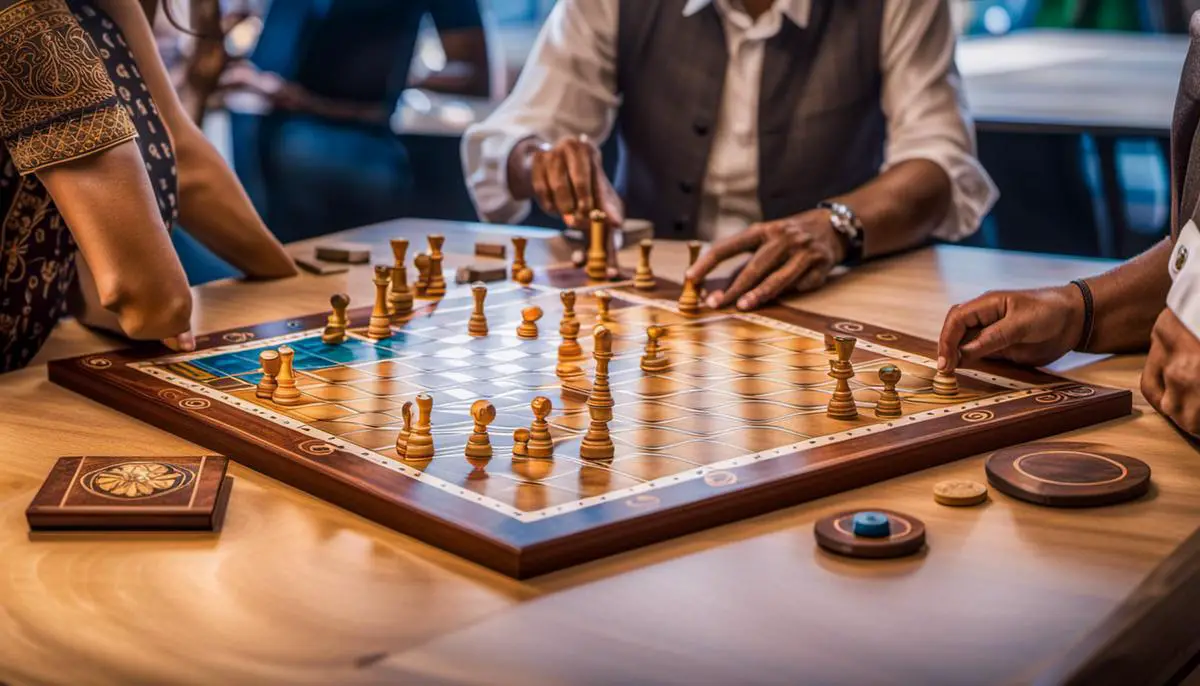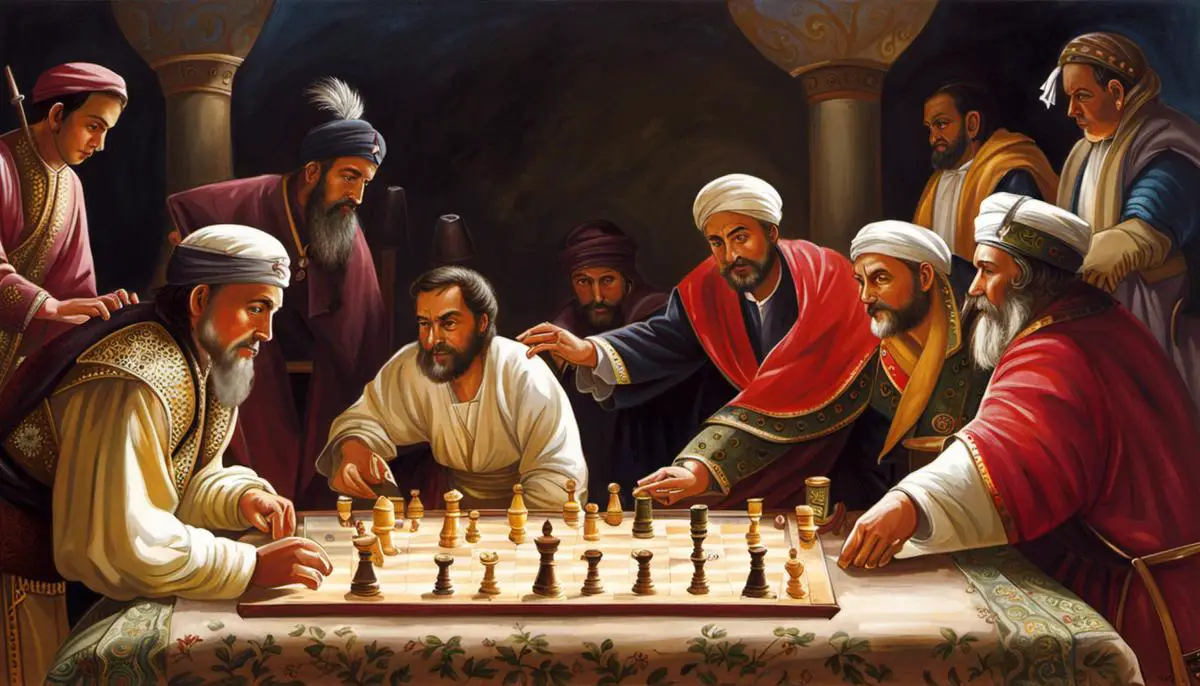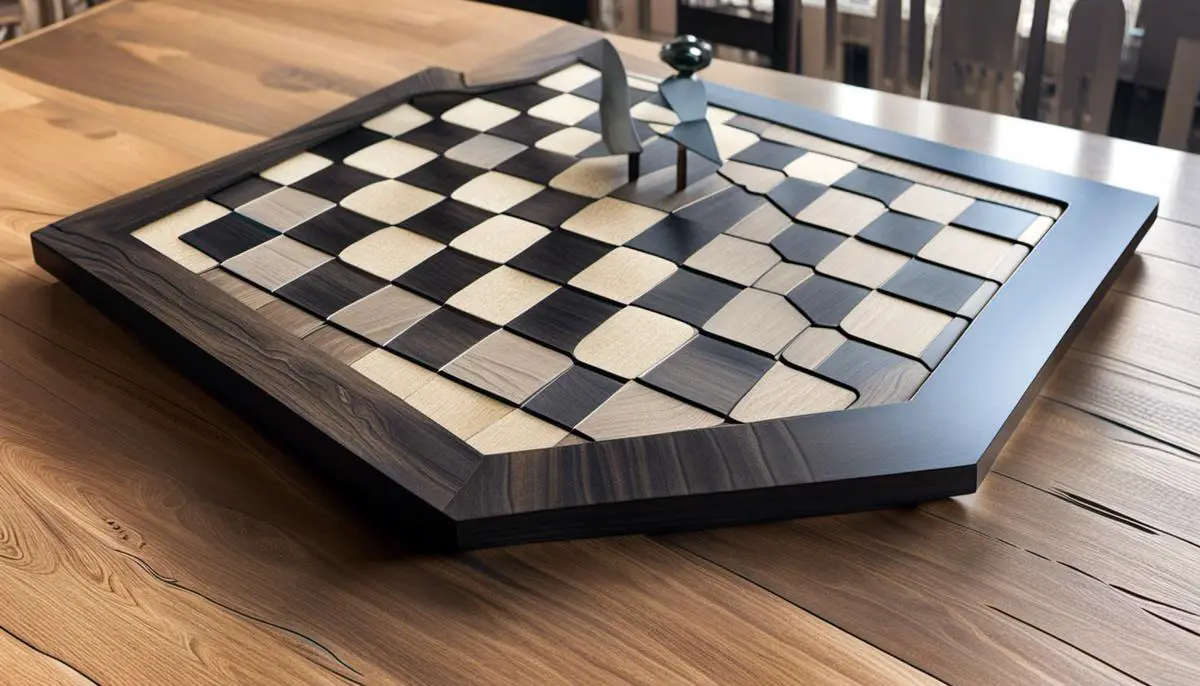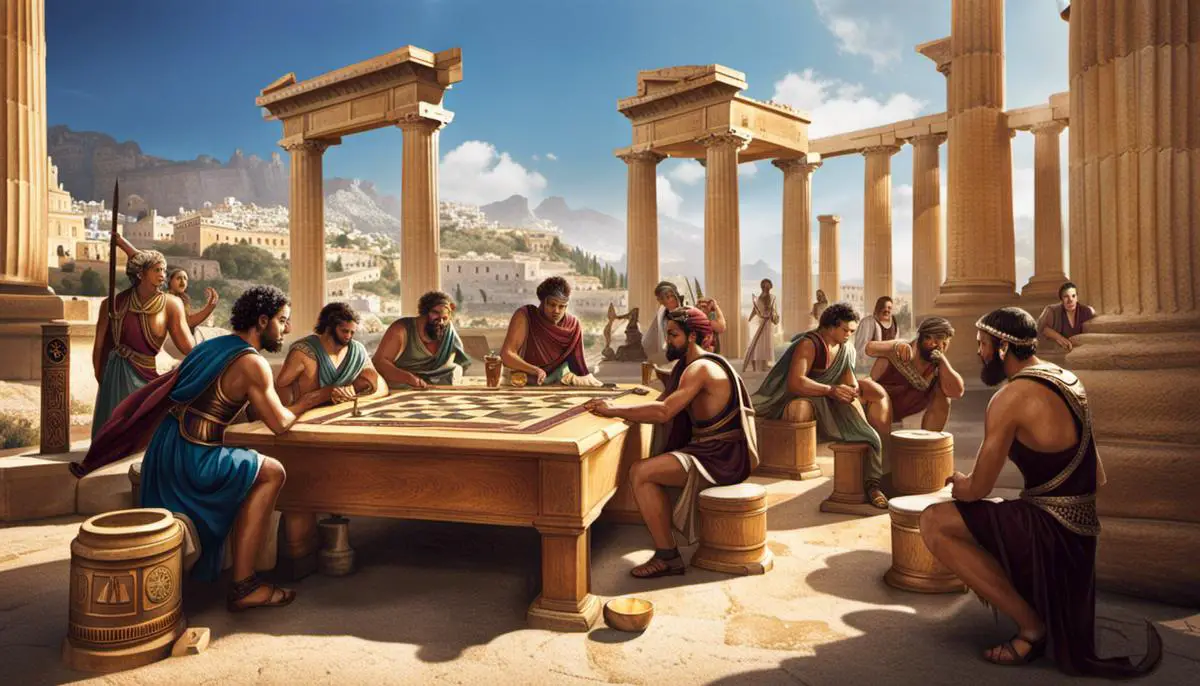The historical roots and cultural significance of ancient games offer a distinctive perspective into the minds and societies of the people from our past, and one such game is Latrunculi, a strategy board game from Greek culture. Evocative of a time where intellect and strategy were highly revered, Latrunculi paints a vivid picture of its influence and role in different social settings of that era. In this exploration, we delve into the historical backdrop, unravel the intricate dynamics of gameplay and rules, study the craft behind the game pieces and board construction, and illuminate the cultural and symbolic attributes of Latrunculi. We also bring to light contemporary adaptations and interpretations, drawing a fascinating continuum between the ancient and the modern.
History of Latrunculi in Greek Culture
The Origins of Latrunculi in Greek Culture
Latrunculi is considered an ancient board game, possibly originating around 6th century BC in Greece. Although the exact origins are hard to pin down due to scarcity of surviving records, the game’s remnants uncovered from archaeological sites, as well as references in historical documents testify to its existence and popularity among Greeks. The game board, often crafted from wood or stone, usually comprised of an 8×8 grid of squares, sometimes varying in size.
Latrunculi: Reflection of Greek Society
Latrunculi, affectionately known as the ‘game of robbers’, is seen as a reflection of the martial society prevalent in ancient Greece. It involved strategy and tactics akin to battlefield engagements, often imitating military formations and maneuvers. Given the nature of gameplay, which centered around capturing the opponent’s pieces, it likely served as a symbol of warfare and combat, central aspects of Greek society at that time.
Gameplay and Societal Influence
The game was usually played by two players, each equipped with differing numbers of varying pieces, with the ultimate goal of trapping or capturing the opponent’s pieces. This gameplay could be seen to echo the ideals of war strategy and tactics, a significant aspect of ancient Greek culture, and may have been used for training and development of strategic thinking skills.
The gameplay was not just confined to the leisurely sphere; it often held social implications. Victory in the game was seen as a demonstration of intellectual prowess and strategic acumen. Being a highly respected game, it was frequently used as a means of social bonding among men and even as a sort of informal dispute resolution tool.
Latrunculi: Role in Wider Greek Culture
Discussions about Latrunculi could frequently be found in contemporary literature and philosophy. Greek philosopher Plato even mentioned the game in his works, suggesting that it was a part of general education in ancient Greece. Moreover, the game has also been depicted in Greek artworks, most notably in ceramics, signifying its cultural significance.
The Ancient Game of Latrunculi
Intrinsically linked to ancient Greek culture, the game of Latrunculi continues to captivate and challenge enthusiasts and scholars to this day. Though not all of its exact intricacies are remembered, given the scarcity of comprehensive written records, numerous efforts to recreate its rules as faithfully as possible have been undertaken.
The enduring interest in Latrunculi serves as testament to its status in the canon of ancient Greek games, drawing in those eager to explore a rich historical context often shrouded in mystique. It’s this allure of the enigmatic that keeps Latrunculi alive, exploring the interplay among history, heritage, gaming, and culture, and creating a bridge between the past and the present.

The Rules and Gameplay of Latrunculi
Latrunculi’s Gameplay: A Glimpse into the Past
Despite the passage of time, Latrunculi—otherwise known as the game of mercenaries—enjoyed a strong presence in ancient Greek and Roman civilizations. While the exact rules and methods of play have faded into antiquity, archaeologists and historians have made surprising discoveries and astute deductions based on unearthed game boards and other artifacts of the time.
From these clues, it appears that Latrunculi was a strategy-based game, typically played on a rectangular grid ranging in size but traditionally consisting of squares often arranged in an 8×8, 9×10, or 7×8 layout. Each game would involve an equal number of disc-shaped pieces, typically 8 to 17, divided into black and white for each player. This, it is believed, represented two adversarial military factions, offering further insight into the cultural context and ideologies of the time.
The Assumed Rules and Gameplay of Latrunculi
Though the exact rules have been lost to time, conjecture suggests it was quite strategic and had similar elements to other games like chess and draughts. Player pieces would move horizontally or vertically but not diagonally. One possible objective was to capture the opponent’s pieces by surrounding them on two opposite sides.
Alternatively, another conjectured objective was to trap or block the adversary’s piece between your own, thereby capturing it. Once a piece was captured, it was removed from the board. Moreover, it’s possible that the objective of the game was to immobilize the opponent’s pieces, marking a win.
Some theories suggest pieces had different ranks or powers, akin to chess, while others point to the possibility of pieces having uniform abilities. Doubts also linger whether there was one special piece, similar to the king in chess, whose capture could mean instant victory.
Reconstruction of Rules: A Hybrid Approach
Given the absence of a definitive rulebook, several modern adaptations of Latrunculi have emerged. These reconstructions usually borrow elements from both checkers and chess. Some versions allow pieces to move any number of squares, while others limit movement to one square at a time.
In most modern reconstructions, the objective is to either immobilize the opponent’s pieces or capture them all. As with chess or checkers, strategic thinking and planning several moves ahead is essential to win the game.
Understanding the Historical and Cultural Context of Latrunculi
The game of Latrunculi holds considerable historical and cultural importance, despite the ambiguity surrounding its original rules. This classic board game gives us a glimpse into the ancient Greek and Roman societies, who had a passionate fondness for strategy-based games. Interestingly, their choice of leisure activities mirrored their military-oriented mindset. Thus, comprehending the game of Latrunculi allows us to better understand these societies’ military tactics and cultural thinking since it’s believed that the game served as a symbolic representation of actual warfare.

Material and Construction of Latrunculi Game Board and Pieces
Design and Composition of Latrunculi Game Boards
Ancient Greece played an instrumental role in shaping the game of Latrunculi which is exemplified in its material selection and design nuances. The primary substances used to create the game boards were commonly found materials, mainly stone types like limestone or marble, and occasionally, wood. The utilization of these materials largely depended on their ease of availability and the economic circumstances of the individual. Greek artisans specialized in etching square patterns onto the chosen material to generate the game board, typically showcasing an 8×8, 8×12, or 10×10 grid design.
While the standard facade of the game board was flat with squares visibly engraved onto it, variations in design sometimes manifested as elevated lines marking the perimeters of the squares. This contrasted playstyle offered a unique gaming experience.
Latrunculi Game Pieces: Material and Design
The game pieces, often called “men,” were primarily made from clay, bone, glass, or stone. There were two sets of pieces, each distinguished by color or sometimes shape, to differentiate between the players’ pieces. Each player would have an equal number of pieces, often ranging from 8 to 16 pieces each.
Most commonly, the game pieces were rounded, similar to modern draughts pieces. However, in some variations, they were designed as miniature versions of warriors or latrunculi – from which the game gets its name.
Regional Differences and Unique Designs
Different areas presented their own unique spins on the design and construction of the Latrunculi board game and its pieces, heavily influenced by regional resources and cultural practices. In parts of Greece where marble was common, you’d often find game boards made from this natural resource. The game pieces were also subject to changes influenced by local traditions and design trends.
In several Mediterranean regions, game pieces carved from ivory, a luxury material, were often seen among the upper classes. These pieces often boasted intricate designs and motifs, signifying the player’s social standing and affluence.
In the Greek islands, where stone was a rare commodity but wood was abundant, carved wooden Latrunculi boards and pieces were the norm. These came with their own visual appeal, often flaunting elaborate patterns and an element of rustic charm.
The divergence in the choice of material and designs showcases the versatility and adaptability of this ancient game. While the aesthetics might differ from one region to another, the central theme of strategic warfare remained consistent across cultures and territories.

Cultural and Symbolic Significance of Latrunculi
The Game of Latrunculi’s Cultural Importance in Ancient Greece
Latrunculi, also known as the “game of soldiers,” was deeply embedded within the fabric of Greek society, offering a snapshot of the cultural values and ideals of that era. The game’s emphasis on tactics and strategy mirrored a culture that revolved around military battles, political strategy, and philosophic debate. The way players worked to capture their opponent’s pieces without surrendering their own reflected the strategic nature of warfare and intellectual clashes on the Agora.
Enjoying a game of Latrunculi was more than just a leisurely pastime, it was seen as a testament to one’s strategic acumen and intellectual superiority. As a result, prowess in this game was often indicative of wisdom and intelligence. Being a master at Latrunculi brought social recognition, cultivating an atmosphere where individuals were constantly in competition, each trying to outshine the other’s strategic abilities.
Influence on Greek Literature and Art
The popularity of Latrunculi did not go unnoticed in Greek literature and art. References to the game, depictions of its play, and metaphors grounded in its rules and strategies permeate a wide array of Greek literary and artistic works.
In literature, renowned poets and playwrights incorporated the game’s nuances into their works, using it as a metaphor to help narrate complex stories of heroism, betrayal, and strategic ingenuity. The mechanics of Latrunculi often served as allegories for real-life struggles and battles.
In visual arts, depictions of people playing Latrunculi can be found on various Greek ceramics, showcasing the game’s vast socio-cultural influence. Artists used the game not just for its scenic value but also to express deeper philosophical ideas about life, fate, and human relationships.
Symbolic Implications of Latrunculi
The game of Latrunculi carried significant symbolic implications that transcended its practical uses. Given its intricate rules and reliance on tactical maneuvers, the game came to symbolize the core aspect of Greek Philosophy — the exercise of reason. Just as players harnessed logic and strategy to win the game, individuals were expected to utilize logical thinking in daily life.
Furthermore, the game’s emphasis on overcoming obstacles through careful deliberation and strategic thinking underlined the dominant social ideology of overcoming life’s difficulties with wisdom and resilience.
In the context of Ancient Greece, the game of Latrunculi was more than mere amusement. It served as a powerful mirror to the society of the time, encapsulating the intellectual chess moves and battlefield strategies that defined the era. The cultural and symbolic essence of this game bore a clear reflection of the societal values, norms, and customs inherent to the age-old Greek civilization.

Modern Interpretations and Adaptations of Latrunculi
Contemporary Approaches to Latrunculi
The realm of ancient Greek games pulsates with intrigue for present-day board game enthusiasts, with Latrunculi being one such enthralling example. Albeit the exact gameplay rules from antiquity have been blurred by the sands of time, modern renditions of the game have been intelligently inferred from historical artifacts, references in the literature, and parallels drawn from comparable games from those times.
Today’s versions of Latrunculi, also known by the moniker of ludus latrunculorum, normally incorporate a board patterned like a chess grid. Diverse pieces, differently colored or designed, are positioned on this board. The crux of the game, as most theories suggest, is to ensnare your opponent’s pieces by cornering them, a technique known as custodian capture. This strategic maneuvering highlights the game’s inherent tactical thinking, providing hints to its potential utilization in military training practices.
Contemporary Adaptations of Latrunculi
In the modern era, game designers have taken the concept of Latrunculi and adapted it, with changes in aesthetics, rules, and even board design. Online adaptations of the game have also gained popularity. These digital versions incorporate interactive elements to recreate classic gameplay with advanced graphics, bringing an ancient game to a new generation.
Virtual reality versions of Latrunculi have been developed wherein players can interact with a three-dimensional board and pieces. The power of technology has allowed the game to be played between individuals in differing geographic locations, fostering global interest and allowing the game to transcend cultural boundaries.
Latrunculi in Modern Greek Culture
Though the game originated in ancient times and was later popularized by the Romans, modern residents of Greece find cultural value in the revival of Latrunculi. The game stands as a historical symbol, bringing nostalgia and appreciation for ancient Greek culture.
The Greek culture physical versions of the game are often found as locally crafted wood or stone sets, available as a novelty item for both locals and tourists. Not only seen as a part of ancient history, Latrunculi is viewed as a bridge to the past and a testament to the rich and enduring culture of Greece.
Popularity Among Board Game Enthusiasts and Historians
Latrunculi’s resurgence in popularity can be attributed to the growing interest in strategy board games and history. Board game enthusiasts find complexity and engagement in its tactical demands. Historians, on the other hand, appreciate the fascinating insight it offers into the pastimes of ancient Greek culture.
Moreover, the intrigue around the loss and recovery of the game’s original rules adds an enticing layer to its mystery, making the game all the more intriguing to historians and board game lovers alike. This unique blend of ancient culture and modern gameplay keeps Latrunculi relevant in the current gaming landscape.

Photo by cieloadentro on Unsplash
The game of Latrunculi is undoubtedly a charming symbol of Greek culture, a beautiful amalgamation of history, craftsmanship, strategy, and art. Rising from the dust of ages, it continues to thrive, while reflecting the societal nuances of its time and offering a glimpse into the intellectual richness of ancient Greek society. Today, as enthusiasts and scholars decipher its gameplay and reconstruct rules, Latrunculi gives us an opportunity to engage with a treasured relic from the past, while enkindling wonder about the timeless human propensity for intellectual entertainment. The resurgence of its popularity not only underscores its timeless appeal but also signals its enduring relevance as we carry the torch of our shared heritage forward.
Frequently Asked Questions: Latrunculi Board Game
A: Latrunculi, also known as Ludus Latrunculorum, is an ancient Greek strategic board game that involves moving and capturing pieces on a grid.
A: In Latrunculi, two players compete on a grid using pieces that move orthogonally. The goal is to capture the opponent’s pieces by surrounding them with your own.
A: Latrunculi was not only a popular pastime in ancient Greece but also had cultural significance, reflecting strategic thinking and tactics valued in warfare.
A: Different variations of Latrunculi were played across ancient civilizations, showcasing the game’s adaptability and popularity in various cultures.
A: Latrunculi requires strategic thinking, spatial awareness, and the ability to anticipate your opponent’s moves. Players need to create opportunities to capture pieces while protecting their own.
A: Yes, Latrunculi’s focus on tactics and capturing opponents’ pieces mirrored the strategies used in warfare, providing players with a mental exercise akin to battle planning.
A: Archaeological findings have unearthed game boards and pieces related to Latrunculi, offering insights into its gameplay and popularity in ancient times.
A: Yes, enthusiasts and historians have recreated Latrunculi based on historical sources, allowing players to experience the ancient Greek game as it was played.
A: To learn more about Latrunculi, you can explore historical texts, archaeological findings, and modern resources dedicated to ancient board games and their rules.
A: Yes, modern versions and digital adaptations of Latrunculi are available for those interested in experiencing the strategic gameplay of this ancient Greek board game.
A: Games like Petteia, known as “The Game of Cities,” shared similarities with Latrunculi, focusing on capturing opponents’ pieces on a gridded board.
